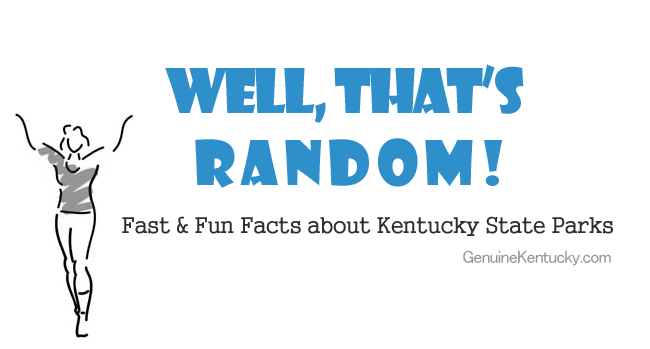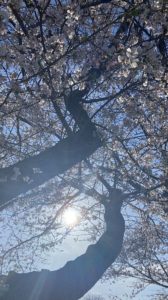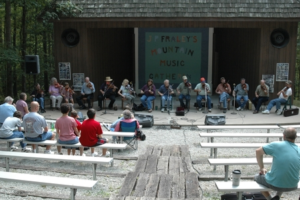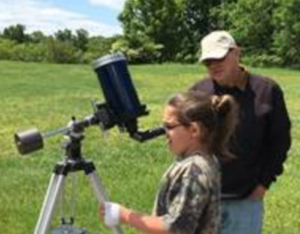Just when you think you know how fascinating our Kentucky State Parks are, you dig a little deeper and realize there’s even more to them than meets the eye. We’re launching a new category on Genuine Kentucky called Random Facts About Kentucky State Parks. Each addition to the category will include 10 facts you probably didn’t know about our wonderful Kentucky State Park System. For example, did you know that the Kentucky State Park System has been referred to as “the nation’s finest” and experiences more repeat business annually than those of any other U.S. State?
Now that’s something to be proud of!
Below are the first 10 random facts. Watch each Wednesday for more. Each state park will be linked to more information and will be followed by the city that state park calls home.
It’s our fervent hope that more people will make their way to each of these amazing state parks and fall in love with them the way we have.
- Kentucky Dam was almost named Gilbertsville Dam. Meaning one of our own personal favorite Kentucky State Parks could’ve been Gilbertsville Dam Village State Resort Park instead of Kentucky Dam Village State Resort Park (Gilbertsville)! Perish the thought.
- Blue Licks Battlefield (Carlisle) is one of the few places in the world where the federally endangered Short’s Goldenrod grows. IN THE WORLD! See it growing alongside an old bison trace in the Kentucky State Nature Preserve within the park. Short’s Goldenrod Festival is held each September.
- Columbus-Belmont State Park (Columbus)will become a favorite spot for Civil War enthusiasts. You can FEEL the history! The site was a strategic location as the North and the South fought for control of the Mississippi River. This struggle led to the Battle of Belmont on November 7, 1861. Today, you can see the massive anchor used by the South to block Union gunboats. You can also see earthen trenches dug to protect over 19,000 confederate troops. My favorite part? A farmhouse that served as a Civil War hospital is now a museum.
- Grayson Lake State Park‘s (Olive Hill) 18-Hole Hidden Cove Golf Course was ranked #4 by Golf Digest in 2005.
- Carr Creek State Park (Sassafras) has the longest sand beach in Kentucky’s State Park System. Carr Creek Lake was once home to some of the area’s earliest pioneer settlements as early as the 1770’s.
- Pine Mountain State Resort Park (Pineville) was the first Kentucky State Park, created in 1924.
- The upper lobby of the Pine Mountain State Resort Park (Pineville) lodge was built in the 1930’s by the Civilian Conservation Corps, a federally-funded program designed to put young men to work during the years of the great depression.
- Big Bone Lick State Park (Union) has been named by the U.S. Secretary of the Interior as a National Natural Landmark.
- E.P. “Tom” Sawyer State Park (Louisville) was named in honor of Jefferson County Judge/Executive Erbon Powers “Tom” Sawyer who was killed in a car accident on Louisville’s Interstate 64 in 1969 while still in office. If you haven’t heard of E.P. Sawyer, you have undoubtedly heard of his beautiful and intelligent daughter, journalist Diane Sawyer.
- Mineral Mound State Park (Eddyville) has a fascinating history. The beautiful property was once the farm of Willis B. Machen. Machen wore many hats – he was a road builder, bridge builder, lawyer, member of the Kentucky General Assembly, and U.S. Congressman. He was also what you’d call a polarizing figure, but more on that in a minute. Mineral Mound State Park is named for his mansion – a stately home he built overlooking the Cumberland River. His granddaughter, Zelda Sayre spent a lot of time at her grandfather’s place while she was growing up. Zelda would go on to become one of the best known figures of the Jazz age as a short story writer. You may have heard of her husband…. F. Scott Fitzgerald. Willis Machen was a supporter of the Confederacy during the Civil War and even flew a large Confederate flag on his property. This blatant show of support for the Confederacy drew cannon fire from a Union gunboat passing along the Cumberland and damaged his mansion. After the war, Machen and his family laid low in Canada until he was pardoned by President Andrew Jackson. They then returned to Kentucky.







So, exactly what is a Mineral Mound? Just the name of the mansion? Surely there was a reason.